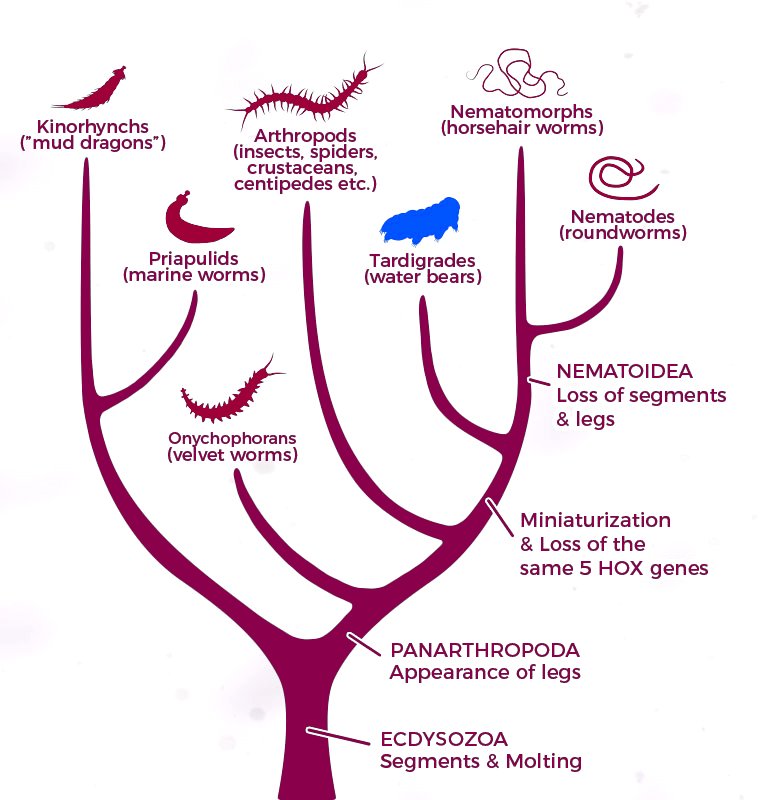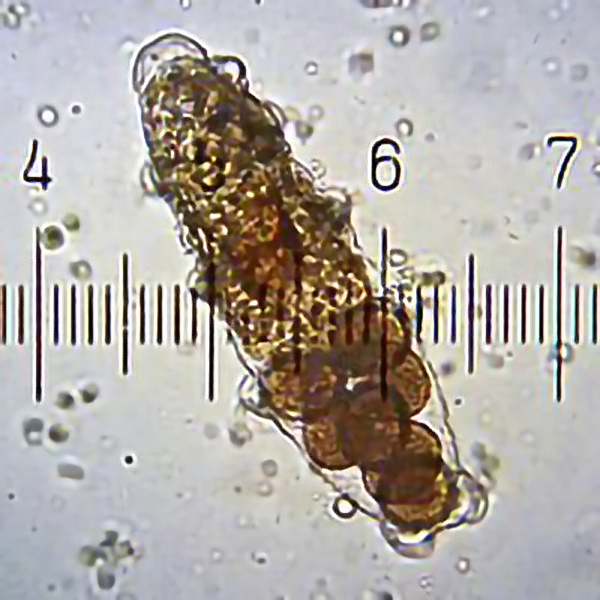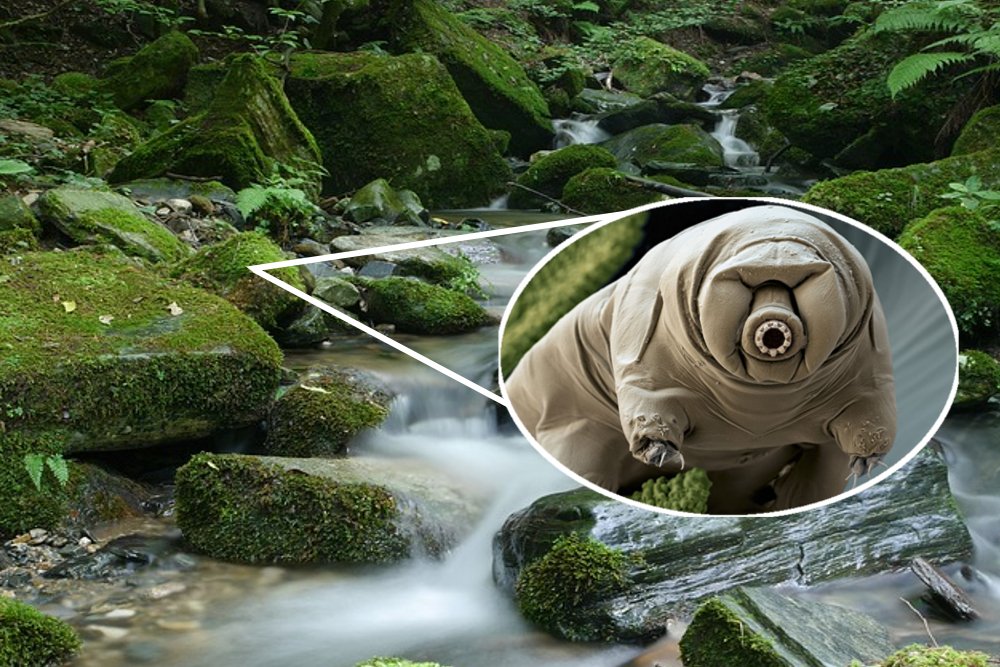Table of Contents (click to expand)
The Tardigrade, also known as a water bear or moss piglet, is the real star in the race of survival. This eight-legged, water-dwelling animal, which is a closer relative to nematodes (roundworms) than they are to their look-alikes, the arthropods (insects, myriapods, arachnids and crustaceans), has gone unseen for a significant part of our existence. Astonishingly, there are over 1200 different species of tardigrades, and it is believed that less than 10% of the species have been identified.
Well, certainly not the dinosaurs, they are long gone, unless a group of mad and enthusiastic biologists try to revive them, in the near future. However, keeping in mind, the current timeline, who else can it be? Humans, the intellectually dominant and technologically advanced species on the planet, can’t possibly be outshone by another.
Alas! That’s simply not the case.
If nature has given us brains to fend for ourselves, it has given the Tardigrades, biological dominance over all existing and previously existant creatures, when it comes to survival. Perhaps, mother nature does it to balance things out.
After all, nature doesn’t play favourites.
What Are Tardigrades?
The tardigrade, better known as a water bear or moss piglet, is the real star in the race of survival. This eight-legged, water-dwelling animal, which is a closer relative to nematodes (roundworms) than they are to their look-alikes, the arthropods (insects, myriapods, arachnids and crustaceans), has gone unseen for a significant part of our existence.
Astonishingly, there are over 1200 different species of tardigrades, and it is believed that less than 10% of the species have been identified.

You might ask—Where have they been all this time? Why didn’t they show up when we were engrossed in exploring the animal species of this planet? Why have they suddenly popped up in an article and earned the title of imperishable creatures that can easily outlive us all?
Well, they have actually been around us all this while; in fact, they’re probably looking at you right now, calling out for you to notice them. However, those calls would be in vain.
Also Read: Why Do Some Creatures In The Deep Sea Grow To Enormous Sizes?
Tardigrades Facts
Tardigrades Size: How Big Are Tardigrades?
The biggest adults reach a body length of only around 1.5 mm, while the smallest is less than 0.1 mm. Newly hatched tardigrades may be even smaller than 0.05 mm. You would need microscopic vision to see these impeccable wonders of nature.

Where Do Tardigrades Live?
Tardigrades occur almost everywhere, but primarily, their happy frolicking habitats are the freshly grown moss that adorns river stones.

Tardigrades live self-effacing lives. They do not cause disease, nor do they have any adverse effects on crops.
What Do Tardigrades Eat?
They feed on the fluids of plant and animal cells, piercing their cell walls and membranes, with the help of primitive piercing mouthparts, called stylets. Some species of water bears are known to engulf entire live organisms, such as rotifers. Tardigrades even eat other tardigrades! Yes, cannibalism is very much alive and well among certain species of tardigrades. When they have enough food and water to support their bodily functions, they live out the natural course of their lives.
They are probably the most paradoxical animals on this planet. These organisms are impossibly cute, like tiny blimps bumbling around harmlessly on their stubby little legs, but they also enjoy a legendary reputation as the toughest and most indestructible creatures on Earth.

Tiny But Robust
Tardigrades have been reported to survive the piping hot sulphur springs amidst volcanic mountains; they have survived atop the Himalayas, beneath layers and layers of thick ice, remaining unscathed by the immense pressures and exceedingly low temperatures. Tardigrades are fully capable of surviving complete global mass extinctions caused by astrophysical events, such as gamma-ray bursts and giant meteorite impacts.

Tardigrades And Ant Man
Pop culture seems to love tardigrades. And with good reason! Tardigrades have been a part of several sci-fi movies, shows, and documentaries. Science fiction loves good space monsters that are biologically dominant to their heroic counterparts. Tardigrades are no stranger to this culture; they have been featured in various movies like Star Trek: Discovery, Ant-Man, and Harbinger Down.
However, was it just their terrifying and gruesome appearance that inspired the filmmakers to caste these critters, or were they well aware of their dominant stature amongst other mortal creatures? Either way, they weren’t wrong!
Also Read: How Does Life Survive In Extreme Conditions?
Tardigrades In Space
In 2007, a group of researchers pushed the resilience of these extraordinary animals to the extreme, in conditions that would be impossible for any other known living creature to survive. A sample of dehydrated tardigrades was exposed to outer space for ten whole days.
The vacuum of space, which results in severe dehydration and cosmic radiation, was not a problem for water bears. When those same specimens were returned to earth and rehydrated, 68% of those shielded from the radiation survived; even a handful of those without radiation protection not only came back to life but also produced viable offspring.
Now that is a true survivor!
How Do Tardigrades Survive For So Long?
The tiny little bodies of these mushy bears are a container of biological brilliance and a storehouse of superpowers that help them withstand conditions that would spell certain death for other organisms.
Cryptobiosis
The adaptation that allows tardigrades to live through such barbarous conditions is their ability to enter a dehydrated state, one that closely resembles death, and this is what makes all the difference.
When encountered with environmental stresses, a tardigrade will moult its skin, and inside the shed skin, it curls up into a dry, lifeless ball called a tun. This reduces its metabolic activity immensely, to around 0.01% of its normal levels, but still protects their DNA. To do this, their body produces trehalose, a natural protective sugar that forms a gel-like medium that suspends and preserves the cell organelles and membranes.
In the tun, a tardigrade can survive for decades or more. Once immersed in water, their bodies return to a normal metabolic state over the course of a few hours.
In one such incident, a group of dehydrated tardigrades was reportedly taken from a museum sample of 100-year-old dried moss and was brought back to life by simple rehydration. That being said, the longer a tardigrade persists in a dehydrated state, the lower are its chances of being successfully revived.
Also Read: Can The Melting Of Arctic Ice Unleash Ancient Pathogens?
Conclusion
Whether it is the scorching heat of thermal vents, the icy cold of subglacial lakes, or even the vacuum of space, these hard little critters will survive it all.

Boil them, mash them, stick ’em in a stew… they are versatile and probably the most durable creatures on the planet. Having survived five great mass extinctions over a period of half a billion years, they might be the strangest combination of cute and terrifying that anyone has ever experienced while looking through a microscope.
Extreme conditions that terrify us and would most certainly kill almost any life form, barely even faze them. These tiny tots have expanded the notion of habitable environments, and understanding their indestructibility will have profound implications for both earthbound medicines and survival on other worlds.
How well do you understand the article above!

References (click to expand)
- Tardigrades as Environmental Bio-Indicators | AMNH. The American Museum of Natural History
- Tardigrades Research Papers - Academia.edu - www.academia.edu
- Pathfinder Science | Tardigrades | Creating the Context. pathfinderscience.net
- Tardigrade Resources - SERC (Carleton). Carleton College
- Tardigrade Facts - Illinois Wesleyan University. Illinois Wesleyan University
- Tardigrades - biochem.iisc.ernet.in:80
